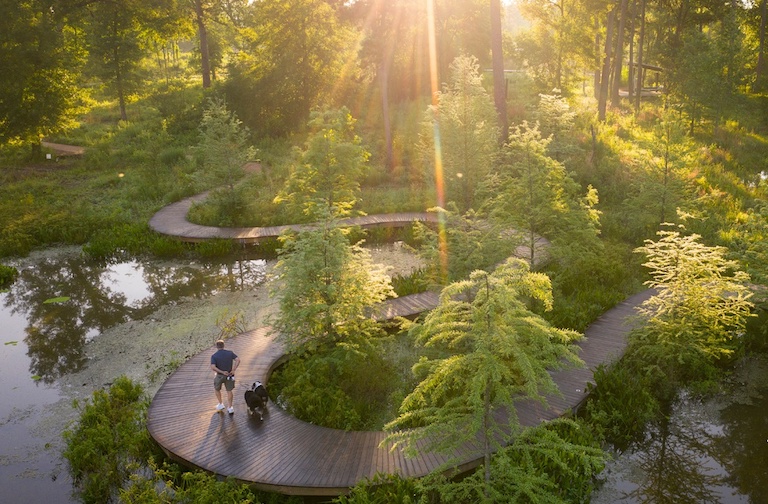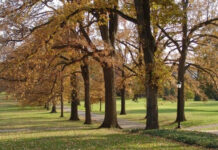
It’s Earth Day! And for inspiration, here’s 10 new projects that were recently added to the Smart Policies for a Changing Climate Online Exhibition from the American Society of Landscape Architects (ASLA). The exhibit demonstrates smart landscape design solutions to climate impacts, such as flooding, extreme heat, drought, and sea level rise and exemplifies best practice approaches in an era of climate change.
The projects include a mix of landscape-based and nature-based solutions across the U.S., which range in scale from residential and school landscapes to masterplans for entire cities and counties. There is also a focus on projects that address climate injustices and meet the needs of historically-marginalized and underserved communities.
“These projects clearly show how landscape architects can help all kinds of communities reduce their risk to increasingly severe climate impacts. Landscape architects design with nature, which leads to more resilient solutions that also improve community health, safety, and well-being over the long-term,” said Torey Carter-Conneen, ASLA CEO.
With these 10 new projects, which were selected with ASLA’s Climate Action Committee, there are now a total of 30 projects featured in the online exhibition, which opened in 2019. Each project was selected to illustrate policy recommendations outlined in the 2017 report produced by ASLA’s Blue Ribbon Panel on Climate Change & Resilience. The new projects were submitted by ASLA members through an open call released in 2019. In partnership with the ASLA Climate Action Committee, projects were selected to represent a range of U.S. regions, scales (from residential to county-wide masterplans), and firm types. The exhibition was funded in part by a grant from the National Endowment for the Arts (NEA).
Best Practice Projects
Cuyahoga Greenways Framework Plan
Cuyahoga County, OH | SmithGroup
Being solely dependent on cars increases communities’ risks to climate impacts. Through the 815-mile Cuyahoga Greenways Framework Plan created by landscape architects and planners at SmithGroup, some 59 communities will have healthier and more resilient transportation connections to downtown Cleveland, Lake Erie, and each other.
Green Schoolyards
Vancouver, WA | nature+play designs
Too few schools offer educational green spaces that can spark children’s appreciation for nature, which is critical to helping them become future Earth stewards. Jane Tesner Kleiner, ASLA, with nature+play designs partnered with school leaders, students, and volunteers to design native plant gardens, meadows, and tree groves that create environmental education opportunities; support pollinators, such as butterflies, bees, and birds; and also manage stormwater.
Houston Arboretum and Nature Center
Houston, TX | Design Workshop and Reed Hilderbrand
By 2012, more than 50% of the tree canopy of the Houston Arboretum and Nature Center had been lost due to drought and hurricanes made more severe by climate change. By removing trees and restoring the original prairie, savannah, and woodland ecosystems found at the Arboretum, landscape architects with Design Workshop and Reed Hilderbrand designed a landscape naturally resilient to future climate shocks. (Pictured above.)
The John W. CookAcademy Space to Grow Schoolyard
Chicago, IL | site design group, ltd
Historically marginalized and underserved communities, like those found in the South Side of Chicago, are disproportionally affected by climate impacts such as flooding. Through the Space to Grow program, a flooded asphalt schoolyard at the John W. Cook Academy, an elementary school on the South Side, was redesigned by landscape architects at site design group, ltd to become a green learning and play space that captures stormwater.

The Kendeda Building for Innovative Sustainable Design
Atlanta, GA | Andropogon
Through their research capabilities and campus infrastructure, universities and schools can also help solve the climate crisis. For the Kendeda Building for Innovative Sustainable Design at the Georgia Institute of Technology in Atlanta, GA, landscape architects with Andropogon integrated an innovative water management system that captures and reuses 100 percent of stormwater runoff from the building and also cleanses and reuses building greywater in the ecological landscape.
NatureScape
Orange County, CA | Jodie Cook Design, Inc.
Climate change has severely reduced the availability of fresh water in arid Western states and turf lawns can require vast amounts of water to maintain. Through NatureScape, an innovative program in Orange County, CA, Jodie Cook, ASLA, helped homeowners transform their turf front yards into water-saving native plant gardens that can sustain a range of native bird, bee, and butterfly species.
Rain Check 2.0
Buffalo, NY | Buffalo Sewer Authority
Climate change is making communities’ struggles with aging sewer systems, which carry both sewage from buildings and stormwater from streets. With more frequent extreme weather events, these systems now overflow more often, causing untreated sewage to enter water bodies. Rain Check 2.0, an innovative program in Buffalo, NY, led by landscape architect Kevin Meindl, ASLA, offers grants to private landowners to capture stormwater through trees, rain gardens, green roofs, and streets.
Randall’s Island Connector
The Bronx, NY | Mathews Nielsen Landscape Architects (MNLA)
Historically marginalized and underserved communities, like those in the South Bronx in New York City, experience higher than average heat risks because they typically have fewer parks and recreational spaces. The lack of safe and convenient pedestrian and bicycle access to nearby green spaces exacerbates the problem. Working with two community groups and the New York City government, MNLA landscape architects designed the Randall’s Island Connector, a ¼-mile-long multi-modal path underneath an Amtrak freight line.
Sapwi Trails Community Park
Thousand Oaks, CA | Conejo Recreation & Park District and RRM Design Group (consulting landscape architects)
In drought-stricken Western states, climate change has added stress to increasingly fragile ecosystems. Instead of moving forward with an earlier plan that could have damaged the Lang Creek ecosystem, planners and landscape architects at the Conejo Recreation & Park District and RRM Design Group designed the Sapwi Trails Community Park to be a model for how to preserve ecological systems while improving access and dramatically reducing water use.
Thornton Creek Water Quality Channel
Seattle, WA | MIG
Climate change and environmentally-insensitive development in the Pacific Northwest are exacerbating negative impacts on salmon. Grassroots environmental organizations sought to daylight the piped Thornton Creek. A new water quality channel was designed by landscape architects at MIG to clean stormwater runoff from 680 surrounding acres before the water flows into the South Fork of the salmon-bearing Thornton Creek.
The upcoming Summer edition of Turf magazine will also focus on “Sustainability & Going Green,” so make sure your subscription is current. This is a Turf edition you’ll want to reference again and again!











![[VIDEO] Dickies®: Discover Workwear That’s Anything But Uniform](https://turfmagazine.com/wp-content/uploads/2023/06/1647663814-4b1a2a7742790a9b1e97a3b963477850192e1d6a9dfba9b07214a77bae25d6e3-d-218x150.jpg)






























![[VIDEO] Dickies®: Discover Workwear That’s Anything But Uniform](https://turfmagazine.com/wp-content/uploads/2023/06/1647663814-4b1a2a7742790a9b1e97a3b963477850192e1d6a9dfba9b07214a77bae25d6e3-d-324x160.jpg)